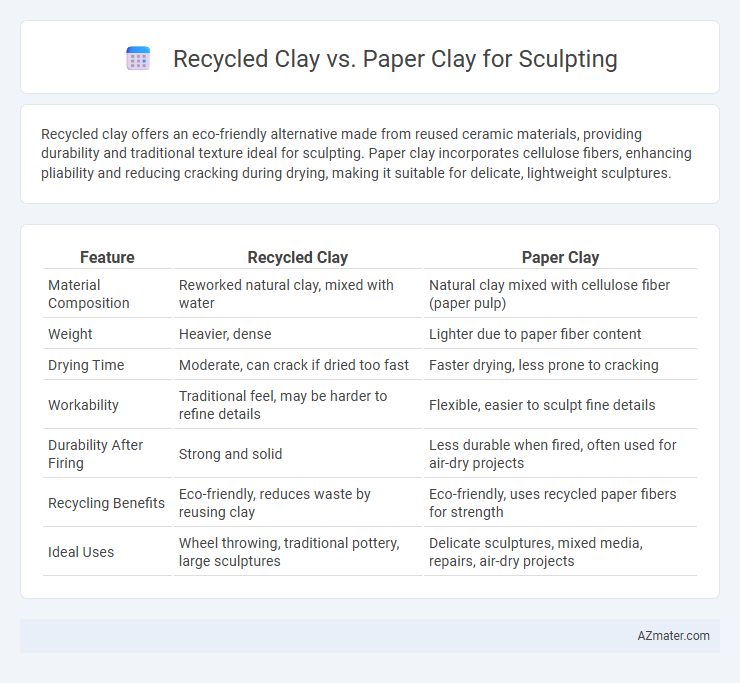Recycled clay offers an eco-friendly alternative made from reused ceramic materials, providing durability and traditional texture ideal for sculpting. Paper clay incorporates cellulose fibers, enhancing pliability and reducing cracking during drying, making it suitable for delicate, lightweight sculptures.
Table of Comparison
| Feature | Recycled Clay | Paper Clay |
|---|---|---|
| Material Composition | Reworked natural clay, mixed with water | Natural clay mixed with cellulose fiber (paper pulp) |
| Weight | Heavier, dense | Lighter due to paper fiber content |
| Drying Time | Moderate, can crack if dried too fast | Faster drying, less prone to cracking |
| Workability | Traditional feel, may be harder to refine details | Flexible, easier to sculpt fine details |
| Durability After Firing | Strong and solid | Less durable when fired, often used for air-dry projects |
| Recycling Benefits | Eco-friendly, reduces waste by reusing clay | Eco-friendly, uses recycled paper fibers for strength |
| Ideal Uses | Wheel throwing, traditional pottery, large sculptures | Delicate sculptures, mixed media, repairs, air-dry projects |
Introduction to Recycled Clay and Paper Clay
Recycled clay consists of previously used clay that has been reclaimed, rehydrated, and revitalized for new sculpting projects, offering an eco-friendly option that reduces waste and supports sustainability in ceramics. Paper clay combines clay with shredded paper fibers, enhancing its tensile strength, flexibility, and drying empathy, making it ideal for delicate or thin sculptures and intricate detailing. Both materials provide unique benefits for sculptors seeking environmentally conscious and versatile mediums in their creative processes.
Composition and Materials Used
Recycled clay typically consists of reclaimed natural clay mixed with water and impurities filtered out to maintain plasticity and reusability, making it an eco-friendly option for sculpting. Paper clay combines natural clay with cellulose fibers derived from paper pulp, enhancing strength, flexibility, and reducing drying time while preventing cracking. The fiber reinforcement in paper clay allows for finer details and thinner walls compared to traditional recycled clay, which is heavier and more brittle when dried.
Environmental Impact and Sustainability
Recycled clay significantly reduces environmental impact by repurposing discarded materials and minimizing the need for new raw clay extraction, which conserves natural resources and decreases landfill waste. Paper clay incorporates recycled cellulose fibers, enhancing strength and reducing the volume of natural clay used, leading to lower overall energy consumption during firing. Both materials promote sustainability by extending the life cycle of raw components and supporting eco-friendly art practices.
Workability and Sculpting Techniques
Recycled clay offers a denser texture with reduced plasticity, making it ideal for chiseling and carving techniques but less suited for fine detail work. Paper clay, enhanced with cellulose fibers, provides superior workability, allowing artists to build delicate, lightweight structures and smooth surfaces with ease. Both materials dry hard but paper clay's flexibility during manipulation makes it preferred for intricate add-ons and joining pieces without cracking.
Drying Time and Shrinkage Differences
Recycled clay typically has a longer drying time compared to paper clay due to its dense, natural material composition, which retains more moisture. Paper clay, infused with cellulose fibers, dries faster and exhibits less shrinkage, reducing the risk of cracks during the drying process. The fiber content in paper clay enhances flexibility, making it more suitable for intricate sculpting that demands minimal deformation.
Surface Texture and Detail Retention
Recycled clay offers a rougher, more organic surface texture that enhances rustic and natural sculptures but may compromise fine detail retention due to its mixed composition. Paper clay, infused with cellulose fibers, provides a smoother surface and superior ability to hold intricate details, making it ideal for delicate and precise sculpting work. Sculptors seeking refined textures and sharp detail preservation often prefer paper clay for its tensile strength and flexibility during drying.
Strength and Durability Comparison
Recycled clay often contains impurities that can weaken its structure, making it less durable for detailed sculpting compared to paper clay. Paper clay incorporates fibers, typically cellulose, which enhance its tensile strength and reduce cracking during the drying and firing process. The fiber reinforcement in paper clay allows for thinner, more intricate sculptures with increased resilience and longevity over recycled clay variants.
Firing and Finishing Processes
Recycled clay typically requires higher firing temperatures, around 1,200degC, to ensure durability and proper vitrification, whereas paper clay can be fired at lower temperatures due to its organic fiber content improving thermal resistance. During finishing, recycled clay offers a denser, smoother surface ideal for detailed glazing techniques, while paper clay provides a lighter, textured finish suitable for matte or unglazed appearances. Both clays respond differently in kiln atmospheres, with recycled clay thriving in oxidation firings and paper clay benefiting from slow drying before bisque firing to prevent cracking.
Cost Efficiency and Availability
Recycled clay offers significant cost efficiency by reusing leftover materials, reducing the need for continuous purchases and minimizing waste in sculpting projects. Paper clay, while often more expensive due to its added cellulose fiber content, provides excellent availability through commercial suppliers and enhanced sculpting properties like lightweight and crack resistance. Artists tend to choose recycled clay for budget-conscious work and paper clay for detailed, durable sculptures, balancing cost and material performance.
Choosing the Right Clay for Your Sculpture
Recycled clay offers an eco-friendly option with durable consistency and is ideal for larger sculptures requiring robust material handling. Paper clay, composed of clay mixed with fibers, provides enhanced workability and reduces drying time, making it suitable for intricate detail and lightweight pieces. Selecting the right clay depends on your sculpture's size, detail needs, drying time, and environmental impact preferences.

Infographic: Recycled clay vs Paper clay for Sculpting
 azmater.com
azmater.com